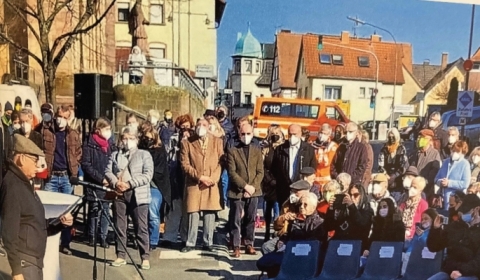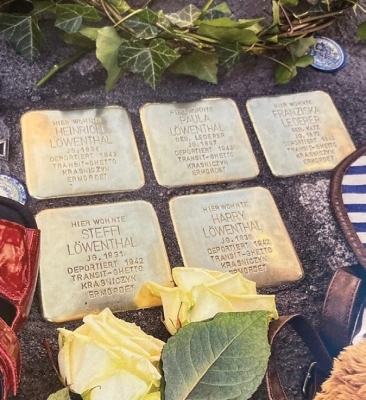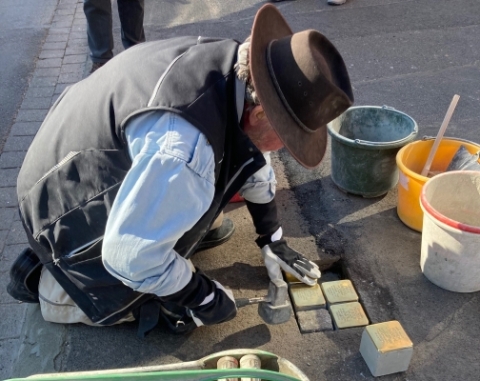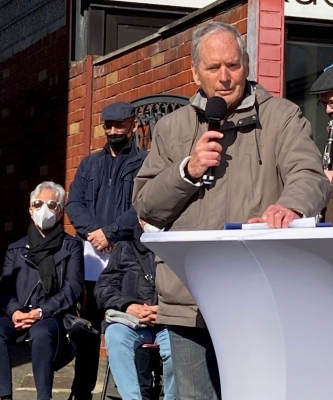Stolpersteine Ceremony in Hoesbach
Friday, March 11,2022 was a very special day for me and my family, I can truly say it was one of the most unforgettable days of my life. It was here in Hoesbach, a little town in `Bavaria that the local Municipality had convened outside the house where my relatives had lived until 1942, to pay tribute to the family who had died in the Holocaust.
The term Stolpersteine (Stumbling stones) is a concept initiated in 1992 in Cologne, by a young German artist called Gunther Demnig. His idea was to commemorate all the victims of the Nazi Regime by having brass plates with the victims' names and dates of birth and death engraved on the plates and placed on the pavement outside the houses that they had lived in.
This movement caught on like wild-fire and today, there are Stolpersteine, not only in Germany, but all over Europe. It is usually the victim's family who instigate the laying of the stones but in our case, it was the Municipality of Hoesbach which initiated and completed the process.
The man behind the idea in our case was a German citizen called Berthold who was born and bred in Hoesbach.
When Berthold was a lad of nine years (in 1958) he helped his widowed aunt in her shop and as a reward she used to take him to the local inn on Saturday nights. There, he met a couple from "Palestine" (his words) who had come back to Germany to claim reparations as promised by the Adenauer Government. The lady was called Amanda Wolf (born Loewenthal) who was born in Hoesbach, but managed to leave Germany with her husband before World War II and made her home in Israel. They were staying in the Inn for a few months until a settlement could be reached.
Amanda's brother Heinrich Loewenthal had been a soldier in the First World War and was wounded twice. He received the Iron Cross for his bravery.
Heinrich married my father's first cousin, Paula Lederer and they had two children, Steffy and Harry. Paula's parents, Simon and Francesca Lederer, joined them in their house in 1937 in Hoesbach, after they had abandoned their house in another village, where the anti-Semitism was especially rife. Simon died of natural causes in 1938 and the rest of the family continued to live in Hoesbach. In 1942 they were rounded up by the Nazis and sent to their death in the Sobibor concentration camp in Poland.
Berthold was fascinated by Amanda and she made a lasting impression on him. The feeling must have been mutual, because before she returned to Israel, she invited him to come and stay with her. His parents kindly declined the offer. This meeting was a turning point for Berthold. Up to then he hadn't met anyone of the Jewish faith and hadn't realized that there had been Jews living in his village up to World War II.
Berthold left Hoesbach to study, got married and now lives in another part of Germany but he still thought about Amanda and her family. Fifteen years ago he decided to research the origins and the fate of the Jews of Hoesbach.
This journey took him many years of study, but eventually in 2016 he made contact with my brother, Rolf Lederer, (who lives in Canada) who supplied him with all the details of the Lederer family.
He then decided to promote the Stolperstein ceremony in Hoesbach together with the Mayor and the Head of the regional council.
The ceremony was scheduled to take place in 2020, but because of Covid was postponed to this year. The remnants of the Lederer and Loewental families, spread all over the globe, were invited to attend the ceremony at the expense of the Municipality.
So on the afternoon of March 11th, I found myself, together with two of my sons, one granddaughter, my niece from London and Amanda's great-granddaughter and her daughter (from Israel) standing in front of the Lowenthal's former house on the Main Street of Hoesbach. The street had been cordoned off and the traffic redirected to an alternative route. When we got there, at 1 p.m. on a cold sunny winter's day, there already was a substantial crowd of people.
We watched as a laborer on his knees, put the final touches to the five stones imprinted with the names of my family who had lived in the house and had been sent to their deaths during the Holocaust. This workman was the artist himself, Gunther Demnig.
The Mayor opened the proceedings emphasizing the importance of the occasion and stressing that we should never forget what happened during the regime of the National Socialists. (All the German speakers never used the term "Nazi." Instead they refer to them as "National Socialists.")
The Leader of the Regional Council (which is a twin Regional council with our own Sharon Coastal Regional Council) said it was the responsibility of the German people never to forget and never to allow these atrocities to occur again.
Pupils from the local School took part in the ceremony. Each pupil described the life and death of each and every member of the family.
My big moment came when I recited Kaddish, firstly in German for the locals and then in the traditional Aramaic. As I recited "Yitgadal Veyitkadash," I nearly choked on the words but battled on, my knees shaking like the leaves in a strong wind. Luckily, one my sons came to my aid and supported me for the rest of the prayer.
Finally, the artist Gunther Demnig himself spoke, describing his project over the last 30 years. He had started on his own but now had 12 other artists who helped him. He estimated that by the end of 2022, there would be almost 90,000 stones all over Europe, which is mind-boggling. But this is a drop in the ocean when one remembers the 6 million who perished.
All the speeches were translated live from German to Hebrew by a local citizen, Oded, an Israeli who had settled in Germany after his army service, some 50 years ago. He lives in an adjoining town and was an expert on the Jewish cemeteries in Lower Franconia. He has written several books on the subject. He was also instrumental in setting up a computerized database of the former Jewish communities in the region. Oded translated with great skill often adding his own comments.
There were interludes of music between the speeches. A clarinet player from Frankfurt played Klezmer music and Hassidic songs. There were songs by the local male choir, including a song that was popular in the late 1920s and sung at that time by a group of six singers, three of whom were Jewish. They were a very successful group in Germany, but their career came to an abrupt end with the rise of Hitler to power.
After the ceremony which was a very emotional and tear-evoking event, we all joined the Mayor and his entourage and other dignitaries in the local sports hall with more speeches, more music and food and drink. But that's another story…..











Comments